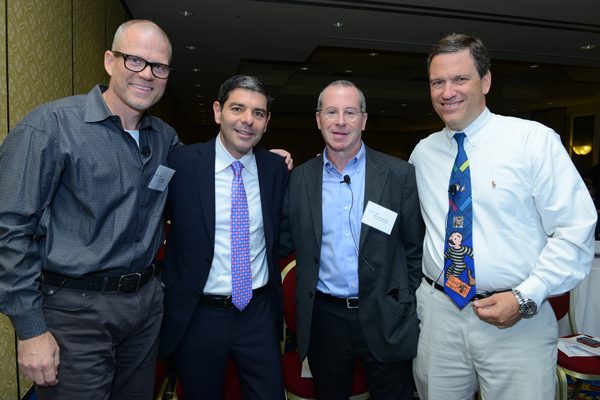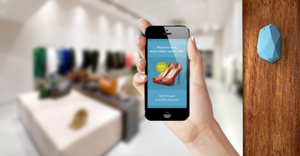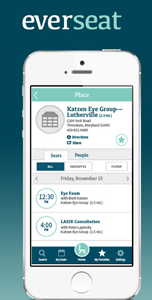
(L to R) Eric Anderson, Lenscrafters; Jonathan Rosin, MD, Rosin Eyecare;
Richard Edlow, OD, Katzen Eye Group;
and Jeff Fromm, FutureCast, at VM LIVE.
LAS VEGAS—Vision Monday’s VM LIVE event, titled “Digitizing the Store,” delivered an important message to attendees last month: technology is escalating at an astounding rate, and its possibilities—especially those for personalization in business-to-consumer interactions—have created a consumer demand for compelling brand experiences at every touch point of the buying experience.
This message resonates throughout any industry. As the prevalence of technology grows, retailers in categories from apparel to home to some of the nation’s leading department and specialty stores are adapting to the needs of shoppers who are digitally savvy, progressively educated and continuously connected. The ability for consumers to engage with a brand or business before, after and during their actual purchase has necessitated that retailers be present throughout the entire customer experience, online and off. This is what’s known as “omnichannel.”
There are many examples of retailers beginning the tricky task of implementing omnichannel:

iBeacon devices are placed in stores to
interact with shoppers.
Macy’s announced last month that it will be rolling out
iBeacons across its 786 U.S. stores, using 4,000 of the devices (which are placed in physical locations such as doorways and product displays to connect to nearby smartphones via Bluetooth) to welcome customers, offer coupons and help shoppers navigate the floor plan of their stores to enhance and ease the shopping experience. According to the
Washington
Post, Lord & Taylor, American Eagle and Duane Reade are trying out the use of iBeacons as well.
Macy's is also reportedly working with Google to enable mobile users to search for products closest to their location, a function set to launch in November, according to
Advertising Age.
Target recently announced the formation of a Digital Advisory Council created for the sole purpose of guiding the company’s omnichannel strategies and furthering its in-store, mobile and online services. The stores and website will use digital platforms including Cartwheel, Target Subscriptions and free in-store pickup services to keep customers connected online and off.
Crate & Barrel, named by
multichannelmerchant.com as one of five companies doing this exceptionally well, uses an app that saves customers’ information so that they may shop and switch between web browsers, smartphones and tablets without having to re-enter their information. Additionally, the app allows customers to manage gift registries, scan barcodes, add items to their shopping carts and make purchases in-store, in real time, with their devices.
So, how does “omnichannel” apply to optical?
The key to omnichannel, our experts agreed, is moving beyond multichannel—interactions in person, on the phone, online or on mobile devices that have become status quo—and creating a seamless interplay between each of these places. Customers must be sought out and attended to across all “channels,” fluidly and simultaneously, not only at the moment they sign into your website or the moment they walk in your door, but at any possibly moment before, after and between.

Everseat is one tool
Katzen Eye Group is
using to go omnichannel.
As Jeff Fromm, president of
FutureCast and author of “Marketing to Millennials,” pointed out in his VM LIVE presentation, consumers today are constantly connected and expect brands to be connected, too. Capabilities like geo-location, wearable technology devices and interactive shopping opportunities are tech trends poised to change the industry and commerce in general.
Richard Edlow, OD, president of the
Katzen Eye Group, described in “Technology Innovation and Solutions” the ways in which his multidisciplinary practice uses specific technologies to provide better patient care and practice to patient interactions:
Brevium patient reactivation software calls patients who have not recently made an appointment;
Everseat turns last-minute cancellations into appointments; and
MyEyeStore, a Minnesota-based company that helps ECPs develop their own online sites and e-commerce stores, frees up staff and allows patients to fill contact lens orders online instead of in-store.
According to Edlow, these tools have generated millions of dollars in revenue for the company.
Lenscrafters, the national’s largest optical retailer, stands out as one of the early implementers of the omnichannel retail model in eyecare. As told to VM LIVE audience members by Eric Anderson, president and general manager of Lenscrafters, the company has created a personalized approach to attracting and growing its customer base by delivering “eye love,” a cheery but strategized customer engagement plan that reaches patients at every point of their purchase. As explained in the video Anderson played in his presentation, Lenscrafters tracks patients from the signup page on Lenscrafters.com, to the AccuExam and AccuFit devices used to test vision and fit eyewear in-store, to the text message reminders to come in for a follow up appointment.
The ways in which to implement omnichannel strategy into retail are many. For more tips on successful omnichannel selling, try these approaches suggested on
the-future-of-commerce.com. For more coverage on “VM LIVE: 'Digitizing the Store,’” visit the full
CLICK report.
Lenscrafters is one optical retailer using omnichannel principles to seamlessly reach customers.